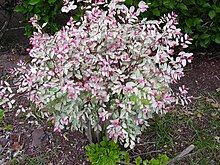
Back Phyllanthaceae Afrikaans أملجية Arabic املجيه ARZ Fillantkimilər Azerbaijani فیلانت کیمیلر AZB Филантови Bulgarian Phyllanthaceae BS Fil·lantàcies Catalan Phyllanthaceae CEB Smuteňovité Czech
| Phyllanthaceae Temporal range:
| |
|---|---|

| |
| Breynia disticha | |
| Scientific classification | |
| Kingdom: | Plantae |
| Clade: | Tracheophytes |
| Clade: | Angiosperms |
| Clade: | Eudicots |
| Clade: | Rosids |
| Order: | Malpighiales |
| Family: | Phyllanthaceae Martynov[2] |
| Tribes | |
|
See text | |
Phyllanthaceae is a family of flowering plants in the eudicot order Malpighiales. It is most closely related to the family Picrodendraceae.[3]
The Phyllanthaceae are most numerous in the tropics, with many in the south temperate zone, and a few ranging as far north as the middle of the north temperate zone.[4]
Some species of Andrachne, Antidesma, Margaritaria, and Phyllanthus are in cultivation.[5] A few species of Antidesma, Baccaurea, Phyllanthus, and Uapaca bear edible fruit.[4]
Phyllanthaceae comprises about 2000 species.[6][7] Depending on the author, these are grouped into 54 to 60 genera. Some of the genera are poorly defined, and the number of genera in the family is likely to change as the classification is further refined. The genus Phyllanthus, one of the largest genera of flowering plants with over 1200 species, has more than half of the species in the family.[8]
Some of the genera have recently been sunk into others, while other genera have recently been divided.[9][10] The largest genera and the approximate number of species in each are: Phyllanthus (1270), Cleistanthus (140), Antidesma (100), Aporosa (90), Uapaca (60), Baccaurea (50), and Bridelia (50).[11]
Since Phyllanthaceae was revised in 2006, one paper has removed Heterosavia from Savia.[12] Another has separated Notoleptopus from Leptopus, and segregated Pseudophyllanthus and Phyllanthopsis from Andrachne. Also, Oreoporanthera has been subsumed into Poranthera, while Zimmermannia and Zimmermanniopsis have been sunk into Meineckia.[13] The large genus Cleistanthus is known to be polyphyletic, but further studies will be needed before it can be revised.[6]
- ^ Kapgate, Dashrath; Manchester, Steven R.; Stuppy, Wolfgang (2017-06-15). "Oldest fruit of Phyllanthaceae from the Deccan Intertrappean Beds of Singpur, Madhya Pradesh, India". Acta Palaeobotanica. 57 (1): 33–38. doi:10.1515/acpa-2017-0004. ISSN 0001-6594.
- ^ Angiosperm Phylogeny Group (2009). "An update of the Angiosperm Phylogeny Group classification for the orders and families of flowering plants: APG III". Botanical Journal of the Linnean Society. 161 (2): 105–121. doi:10.1111/j.1095-8339.2009.00996.x. hdl:10654/18083.
- ^ Kenneth J. Wurdack and Charles C. Davis. 2009. "Malpighiales phylogenetics: Gaining ground on one of the most recalcitrant clades in the angiosperm tree of life." American Journal of Botany 96(8):1551-1570. (see External links below)
- ^ a b Petra Hoffman. 2007. "Phyllanthaceae" pages 250-252. In: Vernon H. Heywood, Richard K. Brummitt, Ole Seberg, and Alastair Culham. Flowering Plant Families of the World. Firefly Books: Ontario, Canada. ISBN 978-1-55407-206-4.
- ^ Anthony J. Huxley, Mark Griffiths, and Margot Levy (editors). 1992. The New Royal Horticultural Society Dictionary of Gardening. The Macmillan Press Limited, London; The Stockton Press, New York. ISBN 978-0-333-47494-5 (set)
- ^ a b Hashendra S. Kathriarachchi; Petra Hoffmann; Rosabelle Samuel; Kenneth J. Wurdack & Mark W. Chase (2005). "Molecular phylogenetics of Phyllanthaceae inferred from five genes (plastid atpB, matK, 3'ndhF, rbcL, and nuclear PHYC)". Molecular Phylogenetics and Evolution. 36 (1): 112–134. doi:10.1016/j.ympev.2004.12.002. PMID 15904861.
- ^ Samuel, Rosabelle; Kathriarachchi, Hashendra S.; Hoffmann, Petra; Barfuss, Michael H.J.; Wurdack, Kenneth J.; Davis, Charles C.; Chase, Mark W. (2005). "Molecular phylogenetics of Phyllanthaceae: evidence from plastid matK and nuclear PHYC sequences" (PDF). American Journal of Botany. 92 (1): 132–141. doi:10.3732/ajb.92.1.132. PMID 21652393.
- ^ Kathriarachchi, Hashendra S.; Samuel, Rosabelle; Hoffmann, Petra; Mlinarec, Jelena; Wurdack, Kenneth J.; Ralimanana, Hélène; Stuessy, Tod F.; Chase, Mark W. (2006). "Phylogenetics of tribe Phyllantheae (Phyllanthaceae) based on nrITS and plastid matK DNA sequence data". American Journal of Botany. 93 (4): 637–655. doi:10.3732/ajb.93.4.637. PMID 21646224.
- ^ Hoffmann, Petra; McPherson, Gordon (2007). "Revision of Wielandia, including Blotia and Petalodiscus (Phyllanthaceae)". Annals of the Missouri Botanical Garden. 94 (3): 519–553. doi:10.3417/0026-6493(2007)94[519:ROWIBA]2.0.CO;2.
- ^ Kanchana Pruesapan, Ian R.H. Telford, Jeremy J. Bruhl, Stefano G.A. Draisma, and Peter C. Van Welzen. 2008. "Delimitation of Sauropus (Phyllanthaceae) Based on Plastid matK and Nuclear Ribosomal ITS DNA Sequence Data." Annals of Botany 102(6):1007-1018. (see External links below)
- ^ "Phyllanthaceae" In: Peter F. Stevens (2001 onwards). Angiosperm Phylogeny Website. In: Missouri Botanical Garden Website. (see external links below)
- ^ Hoffmann, Petra (2008). "Revision of Heterosavia, status novus, with notes on Gonatogyne and Savia (Phyllanthaceae)". Brittonia. 60 (2): 136–166. doi:10.1007/s12228-008-9012-5. S2CID 34814559.
- ^ Vorontsova, Maria S.; Hoffmann, Petra (2008). "A phylogenetic classification of tribe Poranthereae (Phyllanthaceae)". Kew Bulletin. 63 (1): 41–59. doi:10.1007/s12225-007-9012-8. S2CID 21278789.